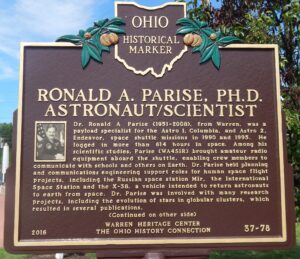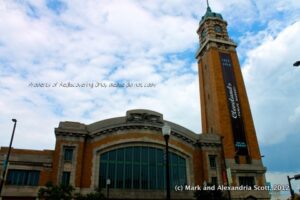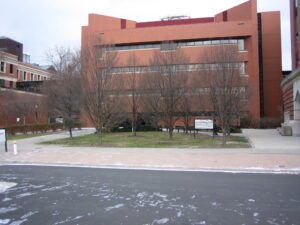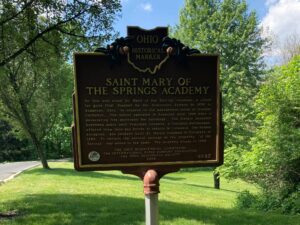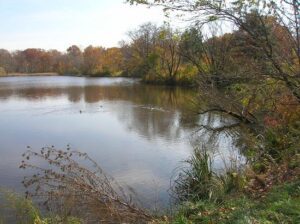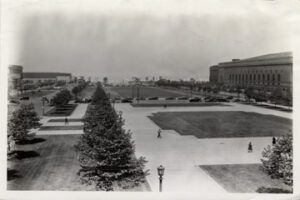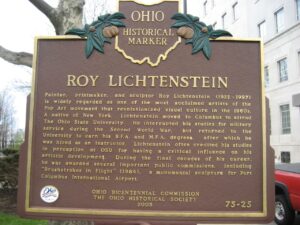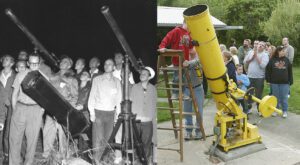, OH
Dr. Ronald A. Parise (1951-2008), from Warren, was a payload specialist for the Astro 1, Columbia, and Astro 2, Endeavour, space shuttle missions in 1990 and 1995. He logged in more than 614 hours in space. Among his scientific studies, Parise (WA4SIR) brought amateur radio equipment aboard the shuttle, enabling crew members to communicate with schools and others on Earth. Dr. Parise held planning and communications engineering support roles for human space flight projects, including the Russian space station Mir, the International Space Station and the X-38, a vehicle intended to return astronauts to earth from space. Dr. Parise was involved with many research projects, including the evolution of stars in globular clusters, which resulted in several publications. (Continued on other side)
, OH
Since opening in 1912, the West Side Market, Cleveland’s oldest continuously operating, municipally-owned market, has been an anchor to the historic Ohio City neighborhood. Built to replace the Pearl Street Market and the Central Market. All three served Cleveland’s growing population in the early 20th century, but only the West Side Market remains. Designed by architects W. Dominick Benes and Benjamin Hubbell, the 30,000 square foot space has a dramatic vaulted Guastavino tile ceiling and a signature clock tower that is 137 feet high. The Seth Thomas clock Company manufactured the clock. (Continued on other side)
, OH
Roy J. Plunkett was born in New Carlisle, Ohio, and graduated from Newton Township High School in Pleasant Hill. He received his B.A. degree from Manchester College before enrolling as a graduate student in chemistry at The Ohio State University, receiving his Ph.D. in 1936 under the direction of William Lloyd Evans in the McPherson Chemical Laboratory. On April 6, 1938, while employed by the Du Pont Company to develop a nontoxic refrigerant, Plunkett discovered Teflon®, one of the most important polymers of the 20th century. On that day, Dr. Plunkett opened a tank of gaseous tetrafluoroethylene only to find that the gas was gone–its molecules had combined with another (“polymerized”) to form a solid material. Teflon has been used on cookware, the outer skin of space suits, nose cones of space vehicles, bone replacement, and much more.
, OH
In 1937, Anne O’Hare McCormick became the first woman to win the Pulitzer Prize for foreign correspondence. She was born in Yorkshire, England and moved to Ohio as a child. She was educated at the Academy of St. Mary of the Springs. As a freelance writer, McCormick contributed to the Atlantic Monthly, the New York Times, and others. She became a regular correspondent for the Times in 1922 and was the first woman to join its editorial board in 1936. As a Times correspondent in Europe during the tumultuous years before and during World War II, she conducted interviews with leaders including Benito Mussolini, Adolf Hitler, Neville Chamberlain, Winston Churchill, and Josef Stalin.
, OH
In 1822, Ralph Russell, a Connecticut pioneer who had settled in Warrensville Township ten years earlier, founded the North Union Shaker Community. The Shakers created Horseshoe Lake in 1852 when they built a dam across Doan Brook and harnessed its waterpower to operate a woolen mill near Lee Road and South Park Boulevard. The community disbanded in 1889; its 1,366 acres were eventually sold to a real estate syndicate from Buffalo, New York, the Shaker Heights Land Company. In 1896, this group deeded the Shaker Lakes Parklands to the City of Cleveland to preserve the green space in perpetuity. Ten years later, the Van Sweringen Company began to develop Shaker Heights Village as a Garden City suburb where William J. Van Aken served as mayor from 1915 until 1950. In the 1960s local residents successfully fought the proposed Clark Freeway, saving Horseshoe Lake and the Parklands from destruction.
, OH
In August 1903, architects Daniel H. Burnham, John M. Carrere, and Arnold W. Brunner presented Mayor Tom L. Johnson and the City of Cleveland a plan that epitomized the City Beautiful Movement in America. The Group Plan envisioned a grand landscaped mall surrounded by public buildings in the Beaux-Arts style. The plan would create a monumental civic center, influence the design of buildings throughout the city, and lay the foundation for a city planning commission. The first of its kind in the nation, the Group Plan, as built, was the most completely realized of Burnham’s city planning efforts. In its green space and architecture, the Mall remains an enduring and vital element of Cleveland’s civic culture. (continued on other side)
, OH
George Bellows (1882-1925) is widely recognized as one of America’s premier artists. His vivid portrayals of modern urban life have become indelible icons of American art. Born and reared in Columbus, he retained close ties here throughout his life. Bellows gained fame while a young artist in New York, becoming a key figure among a group of artists nicknamed the “Ashcan School” because of their preference for commonplace subjects painted in dark colors. Bellows also excelled at printmaking, and it was largely through his efforts that lithography came to be accepted as a fine art in America. Bellow’s career was unexpectedly cut short by his death from complications following an appendectomy at the age of forty-two.
, OH
On October 4, 1957 the Soviet Union surprised the world with the launching of Sputnik 1, the world’s first artificial satellite. The Cincinnati Astronomical Society’s Moonwatch Team, organized in 1956 as part of its participation in the International Geophysical Year, was immediately activated by the Smithsonian Astrophysical Observatory (S.A.O.). First observations of satellites were made December 15, 1957. On these grounds, from 1957 to 1964, the Cincinnati Moonwatch Team, principally under the leadership of Tom Van Flandern (1940-2009), spent thousands of man-hours optically observing and recording data to verify the positions of satellites in space. Many times the team compiled the best satellite tracking records in the world. Because of this work The Moonwatch Team and the Cincinnati Astronomical Society were recognized by the S.A.O. as one of its leading teams worldwide.


